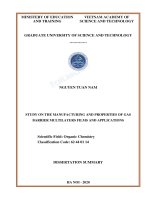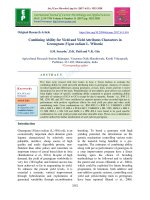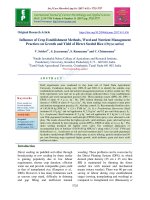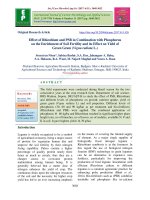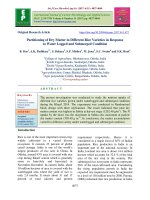Enhanching kharif groundnut (Arachis hypogaea L.) yield and quality in entisol through potassic fertilizer management - Trường Đại học Công nghiệp Thực phẩm Tp. Hồ Chí Minh
Bạn đang xem bản rút gọn của tài liệu. Xem và tải ngay bản đầy đủ của tài liệu tại đây (273.2 KB, 7 trang )
<span class='text_page_counter'>(1)</span><div class='page_container' data-page=1>
<i><b>Int.J.Curr.Microbiol.App.Sci </b></i><b>(2017)</b><i><b> 6</b></i><b>(11): 4068-4074 </b>
4068
<b>Original Research Article </b>
<b>Enhanching </b>
<i><b>Kharif</b></i>
<b> Groundnut (</b>
<i><b>Arachis hypogaea</b></i>
<b> L.) Yield and </b>
<b>Quality in Entisol through Potassic Fertilizer Management </b>
<b>B. Borah*, D.S. Patil and R.B. Pawar </b>
Department of Soil Science and Agricultural Chemistry, College of Agriculture
(Mahatma Phule Krishi Vidyapith), Kolhapur-416004(M.S.), India
<i>*Corresponding author </i>
<i><b> </b></i> <i><b> A B S T R A C T </b></i>
<i><b> </b></i>
<b>Introduction </b>
Potassium is one of the 3 main pillers of
balanced fertilizer use, along with nitrogen
(N) and phosphorus (P). Groundnut is a heavy
feeder of potassium and an adequate supply of
this nutrient is indispensable to harvest a good
crop of groundnut. Potassium plays a vital
role in maintaining balance in enzymatic,
stomatal activity (water use), transport of
sugars, water and nutrient and synthesis of
protein, photosynthesis and starch thus K
application increases growth and yield
attributes in groundnut (Krauss and Jiyun
2000; Rathore <i>et al.,</i> 2014). Out of large
percentage of area in India, very little or no
potassium (K) fertilizers are being applied
and therefore it mainly comes from potassium
reserves of the soil.
Potassium fertilizers are one commodity for
which country depends solely on import.
<i>International Journal of Current Microbiology and Applied Sciences </i>
<i><b>ISSN: 2319-7706</b></i><b> Volume 6 Number 11 (2017) pp. 4068-4074 </b>
Journal homepage:
A field experiment was conducted at Post Graduate Research Farm, College of
Agriculture, Kolhapur during <i>kharif </i>season of 2016 to study the effect of different sources
and levels of potassium (K) on yield and quality of <i>kharif</i> groundnut (<i>Arachis hypogaea</i>
L.) in Entisol. The experiment was laid out in a factorial randomized block design with
two replications in which treatments comprised of five levels of K <i>viz.,</i> 0, 10, 20, 30 and
40 kg ha-1 K2O and four sources of K <i>viz</i>., muriate of potash (MOP), sulphate of potash
(SOP), bagasse ash and schoenite and 25 and 50 kg ha-1 N and P2O5, respectively, was
applied as common basal dose. The results revealed that successive increase in levels of
potassium showed significant effect on yield and yield attributes of groundnut crop, along
with quality. Significantly highest dry pod, kernel and haulm yields (3169, 2213, and 3894
kg ha-1, respectively) were recorded by application of 40 kg ha-1 K2O, and among the
sources, the corresponding highest yields (2770,1926 and 3664 kg ha-1, respectively) were
recorded with SOP which were at par with MOP and Schoenite. Significantly highest oil
yield was recorded by application of 40 kg/ha K2O (1053.7 kg/ha) and SOP (914.55 kg
ha-1) among the levels and sources of K, respectively while interactions were
non-significant. Protein content of groundnut kernel was increased from 22% -24.5% with
application of 40 kg K2O ha-1 over control and among sources significantly highest protein
content was reported with MOP (24.47%) which was superior over all other sources of
potassium. The shelling percentage ranged 67-70 % but the effect of various treatments on
shelling percentage was non-significant.
<b>K e y w o r d s </b>
Potassium, Fertilizer
source, Groundnut
yield, Oil yield,
Protein content.
<i><b>Accepted: </b></i>
28 September 2017
<i><b>Available Online:</b></i>
10 November 2017
</div>
<span class='text_page_counter'>(2)</span><div class='page_container' data-page=2>
<i><b>Int.J.Curr.Microbiol.App.Sci </b></i><b>(2017)</b><i><b> 6</b></i><b>(11): 4068-4074 </b>
4069
Among them for K fertilizers, mainly muriate
of potash (MOP) is completely dependent on
import. Every year India has to spend a bulk
of foreign exchange for importing potassium
fertilizers. The country imported 3797
thousand tons of K fertilizer during 2014−15
(Department of Fertilizer, GOI, 2016).
Among common potassic fertilizers, Sulphate
of potash, is mostly favoured by the majority
of growers since it’s low salt index,
nonhygroscopic and chlorine free K-fertilizer
in comparison with muriate of potash, but
cost expensive. Indigenously, extraction
process of sulphate of potash (K2SO4) and
schoenite (K2SO4, MgSO4) from sea bittern
was developed by Central Salt and Marine
Chemicals Research Institute, Bhavnagar,
Gujarat (Rathore <i>et al.,</i> 2014) and some
private agri-input agencies. Among them,
indigenously produced double salts of K, i.e.,
potassium schoenite (molar mass 415 g mol-1)
have been found to be beneficial on acidic
and alluvial soils which provides a readily
available supply of Potassium, Magnesium
and Sulfur to growing plants in an ideal ratio;
although very little work has been reported so
far. Therefore, keeping the above facts in
background, relative effect of different
potassic sources on yield and quality of <i>kharif</i>
groundnut were studied in the present
investigation.
<b>Materials and Methods </b>
The field experiment was conducted during
the <i>kharif</i> season of 2016-17 at Post Graduate
Research Farm, College of Agriculture,
Kolhapur (16042’ N latitude, 74014’ E
longitude and 548 m AMSL) in sandy clay
loam soil (56.70 % sand, 18.70 % silt and
24.60 % clay) containing available N (150.25
kg ha-1),and moderately high P2O5 (21.37 kg
ha-1) and K2O (252.75 kg ha-1) and 10.35 mg
kg-1 available S.The status of organic carbon
content (0.45 %) was moderate and
moderately calcareous with 4.87 per cent
CaCO3 equivalent. The soil reaction was
slightly alkaline (pH 7.6) and EC was normal
(0.27 dS m-1). The total rainfall received
during the period of field experiment was
1056.50 mm in 63 rainy days. The relative
humidity during the crop period was in the
range of 70 to 91 per cent at morning and 48
to 90 per cent at evening. The minimum
temperature varied from 10.60C to 21.50C,
while maximum temperature was in the range
of 25.30C to 31.90C. The evaporation during
experimentation ranges between 1.4 mm to
5.7 mm per day. The experiment was laid out
in the factorial randomized block design. The
treatments consisted of five levels of
potassium <i>viz</i>.0, 10, 20, 30 and 40 kg ha-1
which were supplied through four different
potassium sources <i>viz</i> muriate of potash,
sulphate of potash, bagasse ash and schoenite.
Groundnut was sown on 28.06.2016 with a
spacing 30 cm x 15 cm. After experimental
layout Bagasse ash was applied as per the
treatments well in advance before dibbling of
groundnut seeds and well mixed in surface
soil. All the recommended agronomic
practices were adopted. Recommended dose
of N and P2O5 (25:50 kg ha-1) was applied to
all treatments through Urea and Single super
phosphate. Oil content was determined by
Soxhlet Ether Extract method
(A.O.A.C.2002)
<b>Results and Discussion </b>
<b>Effect on dry pod, kernel and haulm yield </b>
<b>of groundnut</b>
</div>
<span class='text_page_counter'>(3)</span><div class='page_container' data-page=3>
<i><b>Int.J.Curr.Microbiol.App.Sci </b></i><b>(2017)</b><i><b> 6</b></i><b>(11): 4068-4074 </b>
4070
(Table 2). The highest yield obtained with
SOP might be attributed to its sulphur
content.
Interaction effects of different levels and
sources of potassium were found
non-significant in relation to dry pod yield.
Potassium play vital role in maintaining
balance in enzymatic, stomatal activity (water
use), transport of sugars, water and nutrients
and synthesis of protein, starch and
photosynthesis, thus K application increased
growth and yield attributes in groundnut. The
results are in close conformity with the
observations recorded by Davide <i>et al.,</i>
(1986), Vinod Kumar <i>et al.,</i> (2000), Hadwani
and Gundalia (2005) and Veramani and
Subrahmaniyan (2011) who also reported
response of groundnut to the applied
potassium.
<b>Effect on yield attributes of groundnut </b>
In general, the yield attributes viz., number of
filled and unfilled pods and shelling
percentage were influenced by different levels
and sources of potassium applications.
Significantly highest number of filled pods
plant-1 (38.89) were recorded with application
of 40 kg K2O ha-1 and S2 –SOP (37.10) and
significantly lowest unfilled pods plant-1 were
recorded with L4-40 kg K2O ha-1 (7.88) and
S2-SOP (7.90) (Table 2). However,
interaction effects were found non-significant
in relation to number of filled and unfilled
pods plant-1. The results are in close
aggrement with the findings reported by
Singh and Chaudhari (1996) and Reddy <i>et al.,</i>
(2011) who also reported superior
performance of groundnut to the SOP with
increasing levels of potassium.
The shelling percentage was not much more
influenced by the different levels and sources
of potassium and it was found non-significant.
The highest shelling percentage was recorded
in L4- 40 kg K2O ha-1 (69.90 %) and among
the sources S2- MOP was recorded 69.46 per
cent which was close proximity with the
findings reported by Rathore <i>et al.,</i> (2014).
</div>
<span class='text_page_counter'>(4)</span><div class='page_container' data-page=4>
<i><b>Int.J.Curr.Microbiol.App.Sci </b></i><b>(2017)</b><i><b> 6</b></i><b>(11): 4068-4074 </b>
4071
<b>Fig.2</b> Oil content and protein content of groundnut as influenced by different
potassic sources and levels
<b>Fig.3</b> Oil yield of groundnut as influenced by different potassic sources and levels
<b>Table.1</b> Content of potassium (K2O) in different potassium sources
<b>Sources of Potassium </b> <b>Content of K2O </b>
Muriate of potash 60%
Sulphate of potash 52%
Bagasse ash 0.02%
</div>
<span class='text_page_counter'>(5)</span><div class='page_container' data-page=5>
<i><b>Int.J.Curr.Microbiol.App.Sci </b></i><b>(2017)</b><i><b> 6</b></i><b>(11): 4068-4074 </b>
4072
<b>Table.2 </b>Yield and yield attributes of groundnut as influenced by different potassic sources and
levels
<b>Table.3 </b>Oil content, oil yield and protein content of groundnut as influenced by different
potassic sources and levels
<b>Treatments </b> <b>Oil content (%) </b> <b>Oil yield (kg ha-1) </b> <b>Protein content (%) </b>
<b>Levels of Potassium (kg ha-1) </b>
L0 44.58 655.16 22.82
L1 45.64 743.69 23.51
L2 45.92 835.45 23.83
L3 47.06 955.29 24.12
L4 47.59 1053.71 24.59
S.E.± 0.67 21.27 0.19
CD at 5% 1.98 62.95 0.57
<b>Sources of potassium </b>
S1(MOP) 46.24 856.90 24.74
S2(SOP) 47.27 914.55 23.84
S3(BA) 44.99 769.13 22.79
S4(SCH) 46.13 854.07 23.70
S.E.± 0.60 19.02 0.17
CD at 5% NS 56.30 0.50
<b>Interaction (L x S) </b>
S.E.± 1.34 42.53 0.38
CD at 5% NS NS NS
<b>Treatments </b>
<b>Dry pod yield </b>
<b>(q ha-1) </b>
<b>Kernel yield </b>
<b>(q ha-1) </b>
<b>haulm yield </b>
<b>(q ha-1) </b> <b>Shelling % </b>
<b>Filled pods </b>
<b>Plant-1</b>
<b>Unfilled pods </b>
<b>Plant-1</b>
<b>Levels of potassium (kg ha-1) </b>
L0 (0) 21.74 14.71 33.93 67.63 24.24 9.88
L1(10) 23.68 16.28 35.05 68.73 29.71 9.25
L2(20) 26.25 18.15 35.23 69.08 33.04 8.25
L3(30) 29.26 20.27 37.67 69.26 36.21 8.13
L4(40) 31.69 22.13 38.94 69.90 38.89 7.88
S.E.± 0.57 0.38 0.56 0.52 1.04 0.37
CD at 5% 1.69 1.14 1.67 NS 3.08 1.10
<b>Sources of potassium </b>
S1(MOP) 26.69 18.48 36.58 69.19 32.79 8.60
S2(SOP) 27.70 19.26 36.64 69.46 37.10 7.90
S3(BA) 25.07 17.06 35.49 67.89 28.77 9.40
S4(SCH) 26.63 18.44 35.94 69.13 31.00 8.80
S.E.± 0.51 0.34 0.50 0.47 0.93 0.33
CD at 5% 1.51 1.02 NS NS 2.76 0.98
<b>Interaction (L x S) </b>
S.E.± 1.14 0.77 1.13 1.06 2.08 0.74
</div>
<span class='text_page_counter'>(6)</span><div class='page_container' data-page=6>
<i><b>Int.J.Curr.Microbiol.App.Sci </b></i><b>(2017)</b><i><b> 6</b></i><b>(11): 4068-4074 </b>
4073
<b>Effect on oil content, oil yield and protein </b>
<b>content of groundnut kernels </b>
The oil content and protein content of
groundnut improve significantly with the
graded doses of potassium application.
Significantly highest (47.59 %) oil content of
groundnut kernel was reported with
application of 40 kg K2O ha-1 but effect of
sources and interactions were found non-
significant whereas this value was highest for
SOP (47.27). The results indicated that,
significantly highest oil yield (1053.71 kg
ha-1) was recorded by application of L4 (40 kg
K2O ha-1) which was significantly superior
over rest of K2O levels. Among sources S2
(SOP) recorded significantly highest oil yield
(914.55 kg ha-1) than the rest of K2O sources.
However, the interaction effects were found
non- significant in relation to oil yield (Table
3). Balanced use of nutrients might have
improved the yield attributing characteristics
like root and plant growth, nutrient uptake,
physical, chemical and biological activities
which ultimately results in higher kernel and
oil yield. Increased oil content in SOP was
due to the reason that, sulphur might be
associated with accelerated formation of
acetyl Co- A, a precursor of fatty acids
synthesis and enzyme activities of potassium.
Umar <i>et al.,</i> (1999) and Rathore <i>et al.,</i> (2014)
have reported similar findings in relation to
oil content and oil yield of groundnut.
Protein content of groundnut kernel showed
significant response to added potassium and it
was increased from 22%-24.5% with
application of 40 kg K2O ha-1 over control
and 24.74% protein content was reported with
the source MOP which is superior over all
other sources of potassium applied in the
investigation. Potassium facilitates the uptake
as well as assimilation of nitrogen into simple
amino acids and amides and, therefore
enhanced peptide synthesis which ultimately
contributes to improve protein synthesis.
Similar results were also obtained by Umar
and Moinuddin (2002) and Veeramani and
Subrahmaniyan (2011).
The result from the present study revealed
that, significantly highest pod and kernel yield
of groundnut were recorded with increasing
levels of potassium i.e. 40 kg K2O ha-1 while
among the potassium sources, sulphate of
potash was significantly superior over bagasse
ash and at par with MOP and schoenite.
Highest oil yield and protein content were
recorded with SOP and MOP both @ 40 kg
K2O ha-1, respectively which were
significantly superior over bagasse ash. Low
solubility rate of bagasse ash might be the
probable reason for lower yield and quality of
groundnut compared to other sources.
<b>References </b>
A.O.A.C. 2002. Official Methods of Analysis
Association of Official Agricultural
Chemists Washington, D.C.
Davide, J.G., Nabhan, H., Tahir Saleem, M.
and Nisar Ahmad. 1986. Potash
fertilizers in Pakistan: Sulphate and
muriate of potash. National Fertilizer
Development Centre, Planning &
Development Division, Govt. of
Pakistan, Islamabad. pp. 52
Department of Fertilizers, Government of
India (2016) Import of Fertilizer.
Available on Web:
access on
19th July, 2016.
Hadwani,G.J. and Gundalia, J.D. 2005. Effect
of N, P and K levels on yield, nutrient
content, uptake and quality of summer
groundnut. <i>J. Indian Soc. Soil Sci</i>.
53(1):125-128.
</div>
<span class='text_page_counter'>(7)</span><div class='page_container' data-page=7>
<i><b>Int.J.Curr.Microbiol.App.Sci </b></i><b>(2017)</b><i><b> 6</b></i><b>(11): 4068-4074 </b>
4074
Rathore,S.S. and Chaudhary, D.R.,Vaisya
L.K., Shekhawat Kapila and Bhatt B.P.
2014. Schoenite and Potasium Sulphate:
indigenous potassic fertilizer for rainfed
groundnut (<i>Arachis hypogea </i>L.).<i>Indian </i>
<i>J. tradit.Know. </i>13(1):222-226.
Reddy, S.T., Reddy, D.S. and Reddy, G.P.
2011. Fertilize management for
maximizing productivity and
profitability of export oriented
groundnut (<i>Arachis hypogaea</i> L.) <i>J. </i>
<i>Res. Angrau.</i> 39(4)83-85.
Singh, A.L., and Vidya Chaudhari. 1996.
Interaction of sulphur with phosphorus
and potassium in groundnut nutrition in
calcareous soil. <i>Indian J. Plant Physiol</i>.
New series (1): 21-27.
Umar, S. and Moinuddin, 2002. Genotypic
differences in yield and quality of
groundnut as affected by potassium
nutrition under erratic rainfall
conditions. J. <i>Plant Nutr</i>., 25:
1549-1562.
Umar, S., Bansal, S. K., Patricia, I. and
Magen, H. 1999. Effect of foliar
fertilization of potassium on yield,
quality, and nutrient uptake of
groundnut. <i>J. Plant Nutr</i>. 22
(11):1785-1795.
Veeramani, P. and Subrahmaniyan, K. 2011.
Nutrient management sustainable
groundnut productivity in India – A
review. <i>Int. J. Engg. Sci. Technol</i>.
3:8138-8147.
Vinod Kumar, B.C., Ghose, Ravibhat and
Karmakar, S. 2000. Effect of irrigation
and fertilizer on yield, water- use
efficiency and nutrient uptake of
summer groundnut. <i>Indian J. Agron</i>.
45(4):756-762.
<b>How to cite this article: </b>
Borah, B., D.S. Patil and Pawar, R.B. 2017. Enhanching <i>Kharif</i> Groundnut (<i>Arachis hypogaea</i>
L.) Yield and Quality in Entisol through Potassic Fertilizer Management.
</div>
<!--links-->
Giới thiệu về 3 trường Đại học của Kake Educational institution (Okayama, Kurashiki and Chiba) tại Nhật Bản - Phòng đào tạo - Trường Đại Học Công Nghiệp Thực Phẩm
- 16
- 167
- 0
